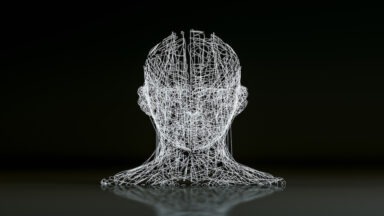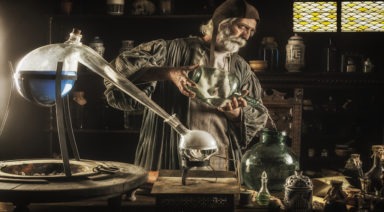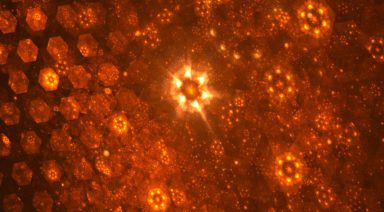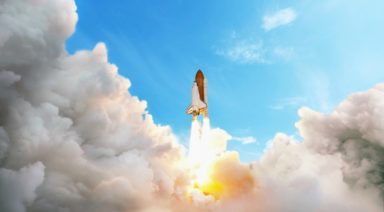The X-37B Conspiracy; Is The Air Force Testing NASA’s EM Drive?
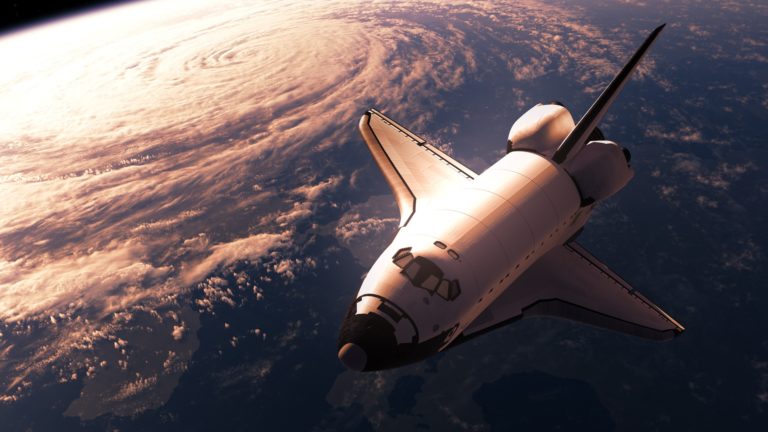
Earlier this year, the Air Force successfully landed one of its X-37B unmanned spacecraft after it spent nearly two years orbiting Earth. Last month, with the help of the SpaceX reusable Falcon 9 rocket, it launched a different X-37B craft for another mission of unknown length. But the duration of this mini-shuttle’s mission is not the only thing undisclosed about the program; everything is. This has inevitably led to a few X-37B conspiracy theories. Is this space drone being used for a nefarious purpose or could it be testing the fuel-less, EM Drive NASA scientists have recently proved feasible?
The X-37B Conspiracy
The X37-B started at NASA in 1999, before being transferred to the Air Force where it was put in the 45th Space Wing program, ostensibly for the development of reusable space vehicles. Though it looks like a miniature version of one of the space shuttles, the X-37B has a more advanced thermal protection layer in addition to some reticent technology inside.
Also known as an Orbital Test Vehicle, Boeing’s secretive “Phantom Works” division spearheaded the plane’s construction, and the elusive nature of the program has led many to believe that it is experimenting with highly advanced intellectual technology. Between the two crafts, the latest launch is the fourth mission which could last anywhere from weeks to years. Some have speculated that the X-37B could be conducting reconnaissance missions on foreign nations or sabotaging foreign satellites that could be perceived as a threat.
But others believe that the Air Force could be in the early stages of launching a program that would weaponize space, causing some panic in the global hegemonic struggle. Both China and Russia have shown concern over the X-37B conspiracy, expressing a desire to create similar crafts of their own. And that fear may be justified, considering that DARPA has also played a role in the plane’s development.

The X-37B courtesy afspc.af.mil
According to the Air Force website, in addition to performing long duration missions and experimentation, the X-37B will test advanced guidance, navigation and control, thermal protection systems, avionics, high temperature structures and seals, conformal reusable insulation, lightweight electromechanical flight systems, advanced propulsion systems, and autonomous orbital flight, reentry, and landing. But despite this laundry list of tests, these technologies are relatively vague and there is not much further detail as to what they are specifically.
The “Impossible Drive,” How an EM Drive Works
The X-37B supposedly runs on a hypergolic fuel system that has been common in jet propulsion since the 1940s. In a hypergolic system propulsion is achieved when two chemicals, usually hydrazine and nitrogen tetroxide, come into contact with each other, eliminating the need for an ignition mechanism. This is a classic system that abides by Newton’s Law, stating that every action has an equal and opposite reaction; in order to achieve thrust, there needs to be propellant pushed in the opposite direction of where you want your craft to go. This, of course, requires fuel and often copious amounts of it.
The idea that thrust can be achieved without a propellant would seem to be impossible. But a recent breakthrough in the development of an electromagnetic engine, or EM drive, may prove to bend these laws, or at least appear to. Based on a hypothetical concept by English engineer Robert Shawyer, NASA has been developing an EM drive under the leadership of Dr. Harold White at its Eagleworks Laboratories at Johnson Space Center.

NASA’s EM Drive courtesy emdrive.com
More technically referred to as a radio-frequency resonant cavity thruster, the EM drive would rely on electromagnetic waves to propel a spacecraft. The traditional rocket propulsion system would be replaced with a microwave cavity that produces thrust from an electromagnetic field. These microwaves would push against the inside of the device causing the craft to accelerate in the opposite direction.
White and his team have measured results from their EM drive that appear to defy Newton’s law of momentum conservation, while producing thrust, sans propellant. Although the results seem anomalous, they have yet to be disproven. Since this announcement, China has claimed to have built its own EM drive and is purportedly testing it in space. Could this be a race between the U.S. and China to develop a revolutionary quantum engine?
The EM drive would undoubtedly make the combustion of traditional rocket propulsion obsolete and would allow for near-limitless travel, if it comes to fruition. There have been rumors that this technology may also prove capable of having the potential to create a warp bubble that would allow for travel near the speed of light.
Other X-37B Mission Speculation
Another new type of propulsion system that has been proven and built by NASA is the Hall-effect thruster, sometimes referred to simply as an ion thruster. This system employs an electric field to accelerate its propellant, usually xenon. By introducing neutrons into a magnetic field and then using electrons to ionize them, the engine can achieve about 70-75% thrust efficiency from this discharge. These ions are then neutralized in the engine’s plume, otherwise the spacecraft would attract them.

Hall Ion Thruster courtesy nasa.gov
This type of system, though not as powerful as combustion rocket propulsion, uses a fraction of the fuel and can last significantly longer, allowing for more distant travel and longer missions. Though it is ideal for these lengthy missions, it trades off time for efficiency.
The Air Force has admitted that it will be testing a Hall-effect thruster during this mission, but could that be the only thing that is being tested? With recent enthusiasm for sending a manned-mission to Mars, particularly with the support of Elon Musk’s SpaceX, it wouldn’t be surprising if they were testing a novel propulsion system that could make the journey more practical. One can only hope that the test is developing technology for the advancement of mankind rather than its destruction.
Nemesis Star Theory; Does the Sun Have an Evil Twin?

Many people remain anxious about the threat posed from a hidden nemesis planet, known as Nibiru, that has been prophesied to collide with Earth. Though many of the proposed dates for this collision have come and gone, there is another celestial body that may be more likely to lead to an apocalyptic event: The Nemesis Star.
The Nemesis Star Theory
Binary star systems occur frequently and are actually more common than single stars. At least that’s what we thought, until a recent hypothesis proposed the possibility that every star starts out as a binary pair or multi-pair system. While the theory hasn’t been confirmed, there is significant evidence that our Sun likely has a twin, an evil twin.
The majority of stars in the galaxy are red dwarfs, which are a fifth of the size of the sun and up to 50 times fainter. These types of stars are pretty commonly paired with another star in a binary system, leading astronomers to believe that Nemesis would be the Sun’s red dwarf star companion. But due to the small size and faintness of these stars, they can be hard to find, making Nemesis all the more elusive.

binary stars courtesy wired.com
This star is thought to be responsible for 12 cyclical extinction events on Earth, including the one that killed the dinosaurs. The Nemesis Star Theory’s roots can be traced to two paleontologists, David Raup and Jack Sepkoski, who noticed that there was a periodicity to major die-outs throughout Earth’s history, occurring in 26 million year intervals. This led to a number of astrophysicists and astronomers, postulating their own Nemesis Star hypotheses.
So how would the sun’s twin be responsible for mass extinctions? The Nemesis Star Theory proposed the idea that the Earth’s binary twin must be in a large 1.5 light-year orbit, retaining just enough gravitational pull between it and the Sun so as not to drift off. But the issue with the orbit of Nemesis is the possibility that it occasionally passes through a cloud of icy debris on the fringe of our solar system, known as the Oort Cloud.
Don’t Perturb the Oort
The Oort Cloud is a theoretical sphere that is believed to orbit our solar system, consisting of planetesimals, the small icy building blocks of planets, comets, and asteroids. These planetesimals are sticky and collide with each other until they become large enough to have a significant gravitational pull, eventually becoming as large as a moon or a planet. They also create asteroids and comets which can be knocked out of orbit and sent hurtling toward the center of the solar system, crashing into planets.
There is a binary star system that once passed close enough to nearly perturb the Oort, and it was likely visible from Earth. Scholz’s Star made a flyby some 70,000 years ago, at a distance of 50,000 astronomical units (AU), with one AU being the distance from Earth to the Sun. The Oort is thought to extend from anywhere between 5,000 and 100,000 AUs and is believed to contain up to two trillion celestial objects. Astronomers are 95% certain that Shulz’s star passed within half of a light-year of us, possibly perturbing the Oort, though apparently not enough to cause a mass extinction event.
Comets are believed to exist within the Oort and are the product of a thief model, a give-and-take of celestial bodies between stars when they’re formed. In this process, comets get pulled back and forth between the gravitational field of stars. It was for this reason that the Oort was theorized, due to the number of comets coming from it, there had to have been a sibling star that pulled them out to the Oort.

The Oort courtesy of space-facts.com
Astronomers also found a dwarf planet in the Kuiper Belt, a region just before the Oort that also contains icy, celestial bodies. This planet, named Sedna, orbits the Sun in a long, drawn-out elliptical path and is one of potentially hundreds. Sedna may help to explain the Nemesis star theory, in that its far-flung orbit was likely caused by our Sun’s twin, pulling it out as it drifted off into the depths of space. Imagine if instead of 9 planets in our solar system, there were a few hundred?
So where is this Nemesis star? Several years ago, the E.U. launched the wonderfully named, Gaia satellite, to map out the stars in the Milky Way and look specifically at stars that have had a close encounter with our solar system or that might come close in the future. But whether or not Nemesis will be found is unknown; it’s possible that it could make a return for the next mass extinction, or it is possible that it drifted off, perturbing the Oort of another star.







